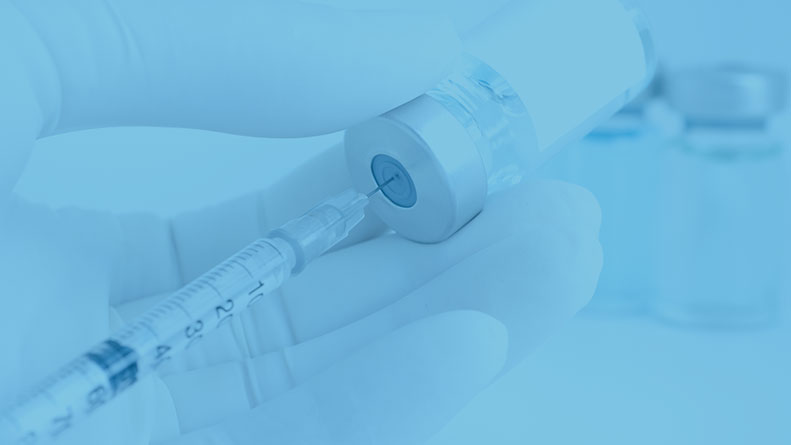
Types of Orthopedic Injections
Corticosteroid
Hyaluronic Acid
Platelet Rich Plasma
Corticosteroid
What is a Cortisone Injection?
Cortisone is a corticosteroid released by the adrenal gland in response to stress and is a potent anti-inflammatory agent. Cortisone is commonly used to temporarily treat inflammatory flare ups, from osteoarthritis, tendinitis, bursitis, or adhesive capsulitis. This conservative treatment option often can help with acute pain, allowing patients to participate in physical therapy.
The medications used in this injection included:
- Marcaine: a long acting anesthetic
- Lidocaine: a shorter acting anesthetic
- Kenalog: a corticosteroid (aka cortisone)
What are the Indications for a Cortisone Injection?
Some of the common indications for a cortisone injection include:
- Osteoarthritis: a condition associated with inflammation of the hip, knee, or shoulder.
- Trochanteric Bursitis: a condition associated with inflammation of the bursa, or fluid-filled sac, near the hip joint. This is a common cause of hip pain.
- Subacromial Bursitis: a condition associated with inflammation of the bursa, or fluid-filled sac, in the shoulder. This is a common cause of shoulder pain.
- Adhesive capsulitis: a condition associated with inflammation of the shoulder capsule, or lining, which results in decreased range of motion and pain.
What Does a Cortisone Injection Procedure Entail?
Cortisone injections are performed in the outpatient clinic. Prior to the injection, the injection site with be cleaned with an antiseptic. The joint will be localized with the use of an ultrasound machine. Prior to the injection, we will use a cold numbing spray to decrease the discomfort from the injection. You will be able to walk out of the clinic on your own that day. As noted, anesthetics are given in combination with the steroid and act to numb the joint. Some, but not all, patients notice immediate relief of their pain because of these medications. This short term relief can last anywhere for 5-12 hours. The actual cortisone may take up 2-5 days to take effect, and is much more gradual in onset than the anesthetics.
Potential Complications From a Cortisone Injection
These injections normally go without any incidents. The most common complaint is pain or soreness at the site of the injection. With this in mind, please be sure to ice the site of injection (20 minutes every 3-4 hours) for the first day or two. This will help decrease any pain that you may encounter. In addition, some patients notice a flare reaction that is really just folks noticing the difference between the relief of pain caused by the anesthetic, and the resumption ofp ain when this wears off and prior to the cortisone kicking in. The ice will help to relieve these symptoms too.
It is extremely rare to develop a serious complication after a cortisone injection in the knee, but possible. If you experience any of the following symptoms, please contact the office:
- Itching
- Drainage
- Swelling
- Fevers
- Redness
- Shortness of breath
- Increased warmth
Please note that the duration of relief afforded by the medication varies greatly among patients. Some patients may not get much relief, whereas others may get relief for weeks, months or occasionally even a year or more.
Hyaluronic Acid
What is a Hyaluronic Acid Injection?
Hyalurononan is a natural substance present in the joint, or synovial, fluid that helps with lubrication. It allows for smooth movement of the cartilage covered articulating surfaces of the joint. When individuals develop osteoarthritis, the synovial fluid becomes “watery” and less oiled. Hyaluronic acid injections, or viscosupplementation, helps replenish the diminished synovial fluid, thereby enhancing its lubricating properties. This also frequently called “gel injections.” Common brand names for hyaluronic acid injections include:
- Euflexxa
- Orthovisc
- Synvisc
- Supartz
- Gel-One
What are the Indications for a Hyaluronic Acid Injection?
Knee osteoarthritis is the most common indications of hyaluronic acid injections.
What Does a Hyaluronic Acid Injection Procedure Entail?
Hyaluronic acid injections are performed in the outpatient clinic. Insurance authorization is required for these injections. Our office will work with you to coordinate approval and shipment of these medications. These injections will be administered over the course of several sessions. Prior each injection, the injection site with be cleaned with an antiseptic. The joint will be localized with the use of an ultrasound machine. Prior to each injection, we will use a cold numbing spray to decrease the discomfort from the injection. You will be able to walk out of the clinic on your own that day. Patients typically begin to notice pain relief from these injections within 1-2 weeks after their final injection. The effects of this treatment can last six to twelve months based on your level of osteoarthritis. These injections can be repeated every six months as needed.
Potential Complications From a Hyaluronic Acid Injection
It is extremely rare to develop a serious complication after a hyaluronic acid injection in the knee, but possible. If you experience any of the following symptoms, please contact the office:
- Itching
- Drainage
- Swelling
- Fevers
- Redness
- Shortness of breath
- Increased warmth
Please note that the duration of relief afforded by the medication varies greatly among patients. Some patients may not get much relief, whereas others may get relief for weeks, months or occasionally even a year or more.
Platelet Rich Plasma
What is a Platelet Rich Plasma Injection?
Our blood consists of a liquid component known as plasma. It also consists of three main solid components which include red blood cells (RBCs), white blood cells (WBCs), and platelets. Platelets play an important role in forming blood clots. They also consist of special proteins, known as growth factors, which help with our body’s healing process. Platelet-rich plasma, or PRP, is a high concentration of platelets and plasma. A normal blood specimen contains only 6% platelets, while platelet-rich plasma contains 94% platelets and 5 to 10 times the concentration of growth factors found in normal blood, thus providing greater healing properties.
What are the Indications for PRP Injection?
PRP is a relatively new treatment method for several orthopaedic conditions such as muscle, ligament, and tendon injuries, arthritis and fractures. PRP injections can help alleviate painful symptoms, promote faster healing and delay joint replacement surgeries.
What Does a PRP Injection Procedure Entail?
PRP injections are performed in the outpatient clinic. These injections will be administered over the course of several sessions. Please note, insurance does not typically cover these injections, but our office will review pricing with you before you begin your series. Before each injection, Dr. Gregory DiFelice will draw about 10 ccs of blood from the large vein in your elbow. This blood will then been spun in a centrifuge machine for about 15 minutes to separate the platelets from the remaining blood components. The injection site with be cleaned with an antiseptic. The joint or injured tissue will be localized with the use of an ultrasound machine. Prior to each injection, we will use a cold numbing spray to decrease the discomfort from the injection. You will be able to walk out of the clinic on your own that day.
- Please hold on strenuous exercise for 3-7 days after each injection.
- Please discontinue any anti-inflammatory medication, including Ibuprofen, Motrin, Aleve, and Meloxicam, one week prior to beginning your injections. You may take Tylenol (Acetaminophen) throughout the duration of your injection series.
Potential Complications From PRP Injection
It is extremely rare to develop a serious complication after a PRP injection in the knee, but possible. If you experience any of the following symptoms, please contact the office:
- Itching
- Drainage
- Swelling
- Fevers
- Redness
- Shortness of breath
- Increased warmth
Please note that the duration of relief afforded by the medication varies greatly among patients. Some patients may not get much relief, whereas others may get relief for weeks, months or occasionally even a year or more.

